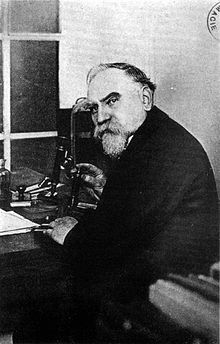Émile Bourquelot (21 June 1851 – 26 January 1921) was a French chemist, and professor of pharmacy at the University of Paris.[1] He was born in Jandun (Ardennes, France), to a farmer, and was the eldest of three sons. Bourquelot became the Chief Pharmacist at the Laënnec Hospital in 1887, where he established a laboratory to conduct his research into carbohydrate chemistry.[2] Bourquelot and other French pharmacists pioneered the study of plant glycosides, molecules in which a sugar is bound to a non-carbohydrate part. They developed methods to stabilize these compounds in solution, and detect them enzymatically.[3] He died at the age of 70 on 26 January 1921 of pneumonia.

The French Academy of Sciences awarded him the Prix Montagne for 1897.[4]
References
edit- ^ "Prof. Emile Bourqeulot". Nature. 106 (2678): 836–37. 1921. doi:10.1038/106836a0.
- ^ Courtois, Jean Emile (1963). Lawrence Wolfrom, Melville Lawrence (ed.). Emile Bourqelot. Advances in Carbohydrate Chemistry. Vol. 18. Academic Press. pp. 1–8. ISBN 978-0-12-007218-7.
- ^ Jupile B, Jaussaud P. (2010). "[The French pharmaceutical school of heterosides (glycosides)]". Review d'histoire de la pharmacie. 57 (364): 375–84. PMID 20481379.
- ^ "Séance du 10 janvier". Le Moniteur Scientifique du Docteur Quesneville: 223–225. March 1898.